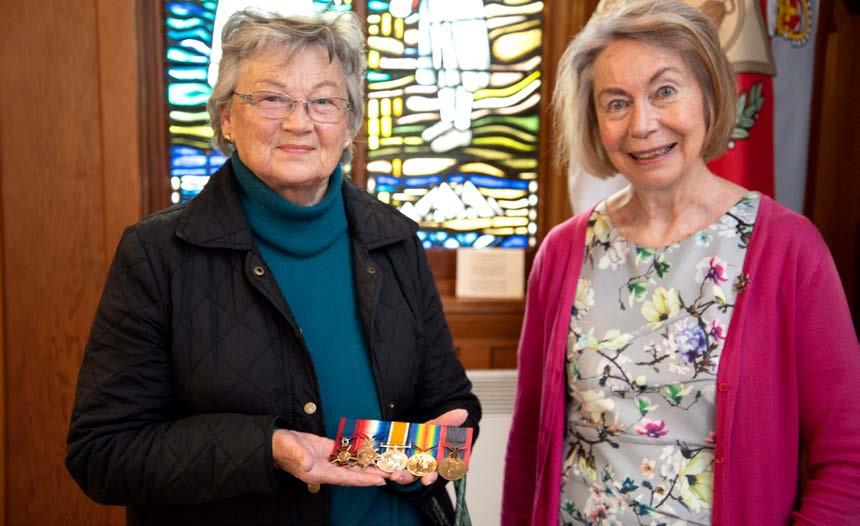
18 minute read
› Introducing the Equally Well SEE US campaign › Helping hand for children having radiation treatment... pg 17–18
Introducing the Equally Well SEE US campaign
People who experience mental health and addiction issues are two-to-three times more likely to die prematurely - because they have poorer access to health support and services, and consequently, significantly poorer health outcomes. Many of these deaths are from preventable and treatable physical health problems. People may not get the care they need, when some health professionals can’t see past those mental health issues, assuming that everything that happens in that person’s life is related to their mental health history. This is called ‘diagnostic overshadowing’ and ultimately can put a person off seeking help or care because of a lack of trust, which in turn may result in those poorer health outcomes. Conceived in Aotearoa New Zealand, the Equally Well Collaborative has launched the SEE US activation campaign nationally and internationally (also in Australia and the U.K) to help correct this imbalance. It is designed to help reduce the risk of diagnostic overshadowing through raising awareness of it as an issue.
Advertisement
In short, the SEE US campaign asks us to listen and trust that the person seeking care is telling the truth about the reasons they are there, and to look past the mental health component of their health history and see the person. The Equally Well SEE US team has produced three short videos, each with a real person telling their own story – these are not made up scenarios, they are people with lived experience of diagnostic overshadowing. In just under a minute, each story illustrates the issue far better than written words ever could. Towards the end of each message, we get to see the person, as well as the issue, more clearly. Follow these links to watch the videos:
› Jess's story › Rika's story › Ross's story From this Mental Health Awareness Week (26 September to 2 October) onwards, why not play an active part in resetting the balance by listening better, by trusting and by seeing the person. For more information, visit Tepou.co.nz - the equally well SEE US campaign

1
AOTEAROA, NEW ZEALAND - SOME KEY FACTS
ISBN 978-1-98-855174-6
Life expectancy reduced by up to 25 years
Two-thirds of premature mortality for people experiencing mental health and addiction issues is due to preventable and treatable physical health conditions -particularly cancers and cardiovascular disease.
Co-existing issues are the norm
2 Around 3 in 5 adults experiencing mental health issues report having one or more long-term physical health issues.
3
Cancer
The likelihood of cancer survival for people who experience mental health and addiction issues is reduced by 3 times for colorectal cancer and 2.5 times for breast cancer.
4
Medication
Some psychiatric and addiction treatment medications contribute to poorer health outcomes, for example cardiometabolic issues, particularly weight gain, and poor oral health.
Substance use
People with problematic alcohol use have almost double the risk of developing a wide range of cancers. People with methamphetamine use disorders are more likely to experience heart disease, cerebrovascular complications, oral health diseases and increased transmission of blood borne viruses.
75% of people who receive opioid substitution treatment are likely to have Hepatitis C.
5
1. Cunningham, R., Sarfati, D., Peterson, D., Stanley, J. & Collings, S. (2014). Premature mortality in adults using New Zealand psychiatric services. New Zealand medical journal, 127(1394), 31-41. 2. Scott, K. M., Bru aerts, R., Simon, G. E., Alonso, J., Angermeyer, M., de Girolamo, G., Von Kor , M. (2007). Obesity and mental disorders in the general population: Results from the world mental health surveys. International Journal of Obesity, 32(1), 192–200. doi:10.1038/sj.ijo.0803701. 3. Cunningham, R., Sarfati, D., Stanley, J., Peterson, D. & Collings, S. (2015). Cancer survival in the context of mental illness: a national cohort study. General hospital psychiatry, 37(6), 501-506. 4. Correll, C. U., Detraux, J., De Lepeleire, J. & De Hert, M. (2015). E ects of antipsychotics, antidepressants and mood stabilizers on risk for physical diseases in people with schizophrenia, depression and bipolar disorder. World Psychiatry, 14(2), 119-136.
Kisely, S., Baghaie, H., Lalloo, R., Siskind, D. & Johnson, N. W. (2015). A systematic review and meta-analysis of the association between poor oral health and severe mental illness. Psychosomatic medicine, 77(1), 83-92. 5. Te Pou o te Whakaaro Nui (2014). The physical health of people with a serious mental illness and/or addiction: An evidence review. Auckland: New Zealand.

Helping hand for children having radiation treatment
Children going through radiation treatment for cancer at Christchurch Hospital are benefiting from ‘3D Countdown Posters’ created especially for them in a collaboration with The Y (formerly YMCA). When a child comes in for radiation treatment, a model or puzzle individualised to the child’s age or interest to count down to their final treatment on is made by young people attending The Y’s ‘4C Centre’.
The centre is a free technology space equipped with 3D printers, robotics, augmented and virtual reality equipment, work spaces, laptops, computers and more for youth. Paediatric Coordinator Radiation Therapist Lydia Crighton who coordinates radiation treatment for paediatric patients aged 0-12 in the South Island and Wellington region, says the ‘3D Countdown Posters’ are a real highlight for the children, giving them an understanding of how many treatments they’ve had and how many they have remaining. “Children get to take them home at the end of treatment, marking a significant part of their cancer journey.” The Radiation Therapy team try to make radiation treatment as much fun as possible for the child and their family. “Each child has a personalised treatment routine we complete each day to ensure they feel comfortable and safe and can have a little fun in our department.” “This typically involves 10 minutes of play with their Radiation Treatment ‘Buddy’, completing a treasure hunt into the treatment room, collecting their glow in the dark Radiation Treatment bead and completing their treatment poster/puzzle that has been kindly donated by The Y. “We are truly grateful for the time and effort put in by The Y to help make kiddos smile throughout their cancer journey,” she says. The parents of a child who received radiation treatment recently say they all “absolutely loved” the ‘3D Countdown poster’ he received. “It was one of the many things that was done for him to ensure what would be an otherwise very scary experience could be turned into some fun each day. The Y’s volunteers did an amazing job producing it, and we really appreciate the idea and think it was a fantastic thing to help add a little excitement, and we valued being able to mark off each treatment day.”
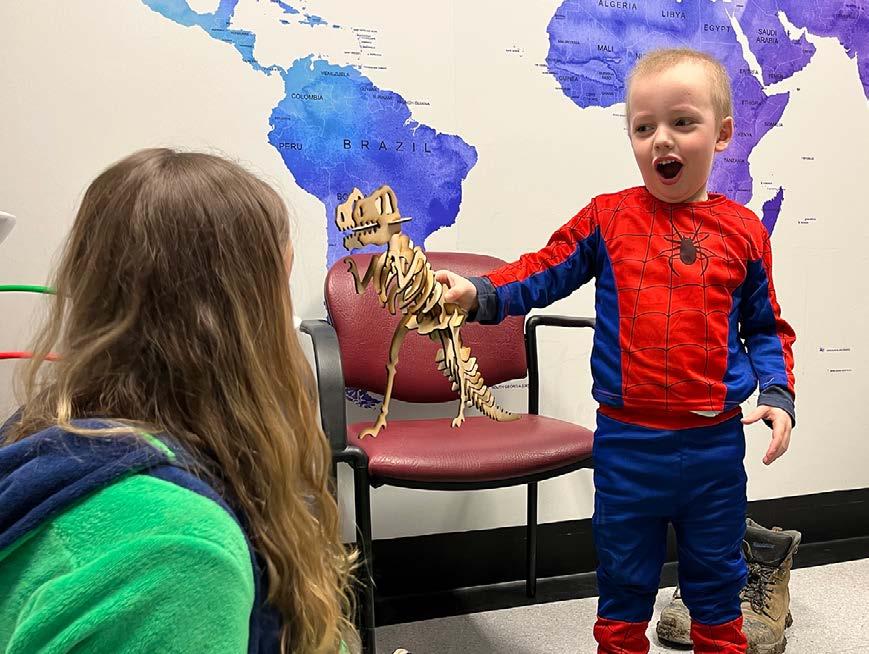
From left, Radiation Therapist and Paediatric Buddy Freya and Connor with his ‘3D Countdown Poster’
At left, Radiation Therapist and Paediatric Buddy Freya Jackson and far right Radiation Therapist and Paediatric Co-ordinator Lydia Crighton with Jake and his mother on his last day of Radiation Treatment. Jake is holding his ‘3D Countdown poster’
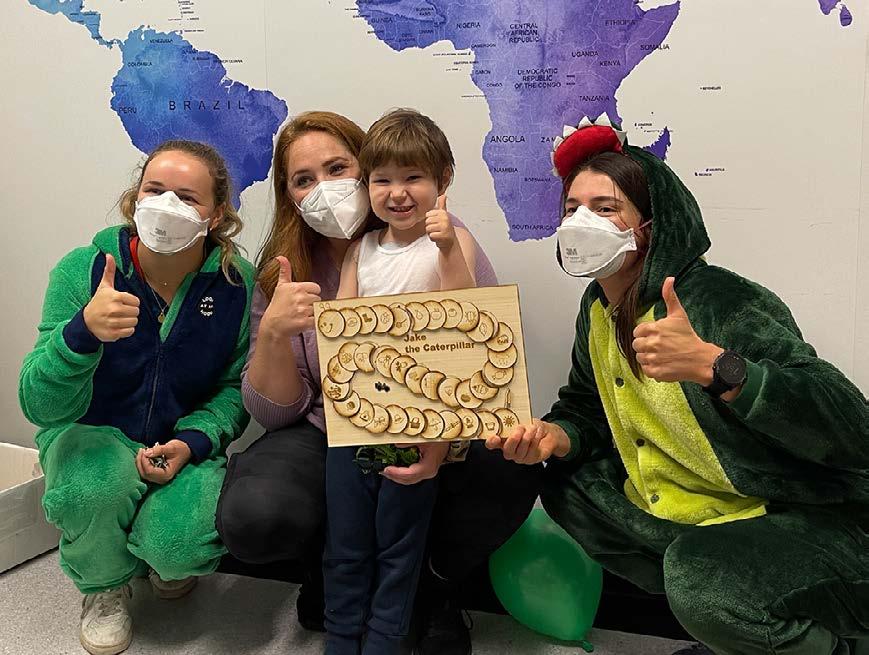
Paediatric Radiation Oncologist Chris Harrington says the items are a welcome addition to the philosophy of making radiation fun and positive for the child and their family. “They help overcome worries and speed up relaxation around the treating team and equipment. It can help some children to be confident enough to avoid having weeks of daily anaesthetic (used to keep the child still) for their treatment.”
The Y 4 C Centre Coordinator Clark Williams says young people aged between 14 and 20 are involved in the project. They receive the name and interest of the child and either an idea comes up immediately or they brainstorm to achieve the right concept. “There is a mix of skillsets here at the centre and some of our young people make them unassisted while others are supported to learn the completely new skills required. We usually use the laser cutter because it’s a really accessible technology to teach young people and also get some really cool results from. “We'll often look back at other designs and think about how we can top the last one so that we're always improving and the kids are getting really cool designs each time.” While the simpler ones can often be completed in an afternoon, some of the more complex take a few days of intermittent work, he says.
Waitaha Canterbury staff mark World Alzheimer’s Month
September is World Alzheimer’s Month and each September, people unite from around of the world to raise awareness and to challenge the stigma that persists around Alzheimer’s disease and all types of dementia. The focus for this year is ‘Know dementia: Together we can do so much’. The aim is to encourage everyone to understand dementia and how we can all support people living with dementia after their diagnosis. Dementia is everybody’s business, as a quick look in Canterbury’s general practice waiting rooms, home-based care and rest home care recipients, and hospital inpatient wards shows. During September, we encourage everyone to support World Alzheimer’s Month by getting involved in some way.

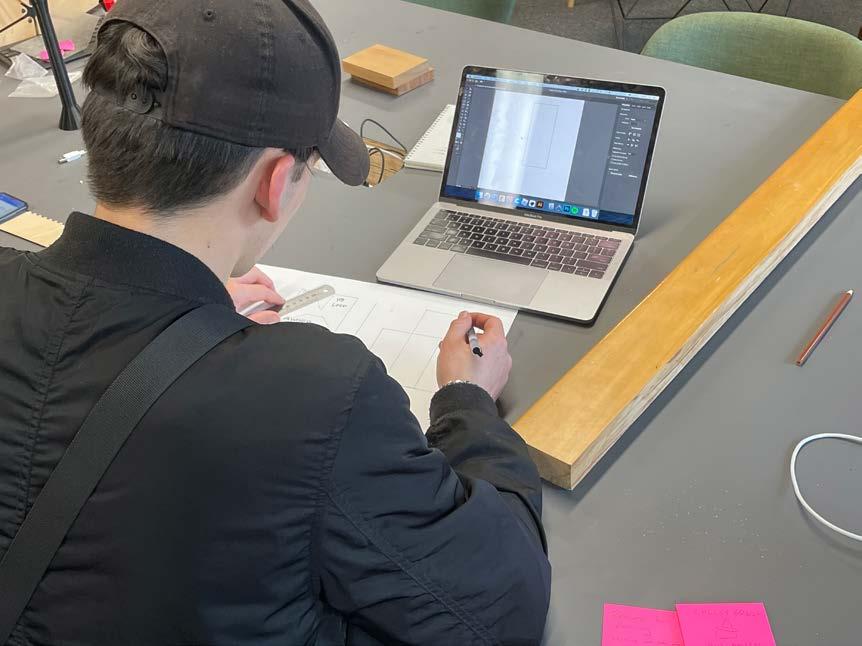
A young person at The Y’s 4 C Centre working on a ‘3D countdown poster’
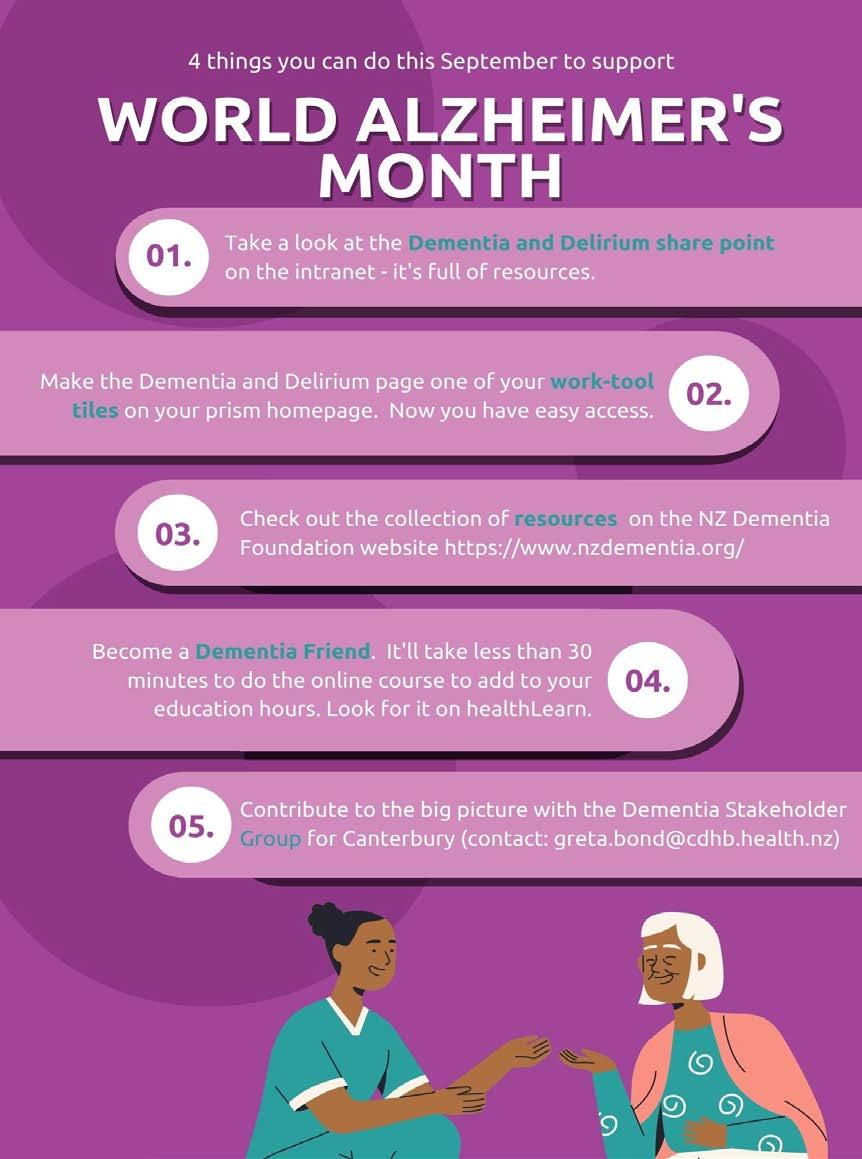
Kōwhai Companions programme celebrates success
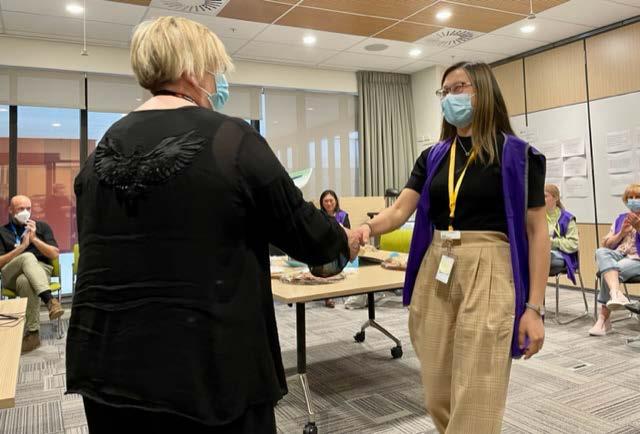
Kōwhai Companions Volunteer Jenna Feng receives her certificate of appreciation from Executive Director of Nursing Becky Hickmott
Kairuruku Hōtaka/ Programme Coordinator of Kōwhai Programme Fiona Graham (centre) with Kōwhai Companion volunteers at the afternoon tea
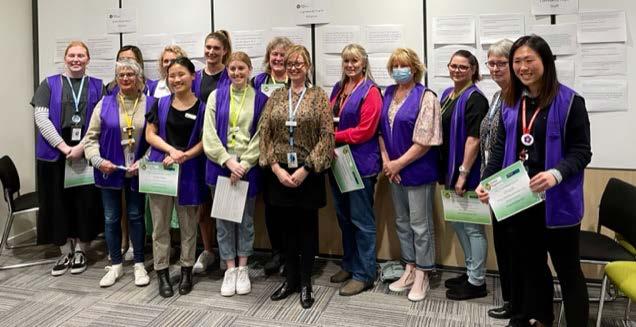
An afternoon tea was held at Burwood Hospital last week to thank and celebrate the contribution that the Kōwhai Companions have made to ensure the success of the Kōwhai Programme. Kōwhai companions are volunteers who are selected and trained to provide person-centred engagement with vulnerable patients in hospital, and many of these patients are people living with dementia.
“Collectively the Kōwhai Companions, which have included two groups of Speech Language Therapy students, have provided 1120 hours of time to over 120 different patients over the last nine months, they are amazing people,” says Kairuruku Hōtaka/ Programme Coordinator Fiona Graham. Feedback from the programme shows that presence of a Kōwhai Companion is beneficial for the patients’ emotional wellbeing, as well as giving whānau a valued sense that their loved one is in caring company that improves the hospital experience. “In their time with patients, the Kowhai Companions can be supporting hydration, nutrition and overall physical wellbeing, they are all factors which can contribute to a reduction in rates of delirium and the adverse events associated with it,” Fiona says. A few of the quotes about the programme include: “I don't get many visitors, I enjoyed having someone to talk to. I liked it when they took me outside, the volunteers were the best thing about my stay, this has done more for me than anything else.” (Patient) “Amazing, gave her normality, sitting out in the lounge and getting out on the ward. You guys were amazing, all I can say is amazing. It never looked like hard work and (the patient) can be quite difficult. The best quality time she had was with the volunteers!” (Family member) “I have loved seeing the change in patients after the time spent with their Kōwhai Companion, they often appear more settled…. I think it is a great thing for the nursing staff too as the time spent with the companion allows them to attend to other things. I personally love the service and think the initiative is wonderful” (Staff member) National Dementia Leadership Group announced Budget 2022 allocated $12 million over four years to begin implementing the Dementia Action Plan. This will see the development of two interconnected sector groups, the Dementia Mate Wareware Leadership Group (DLG) and the Dementia Network. The DLG will provide leadership and advice to Te Whatu Ora and Te Aka Whai Ora on strategic alignment, direction, and integration across the system to ensure delivery against the objectives and actions in the Plan.

Congratulations to Waitaha Canterbury Psychiatrist of Old Age Matthew Croucher who has been appointed as the deputy chair. Kia ora mo to tono hou i DLG, Matthew.
“The last twelve months have brought a string of great news for the dementia sector here in Waitaha / Canterbury and around the motu”, says Matthew. › A national bicultural Dementia Mate Wareware
Action Plan was adopted by government and the sector last September. › Cabinet formally approved it in November, financial support was announced in the government’s Budget in May. › The Dementia Leadership Group was formed this month, supported by the appointment of the New
Zealand Dementia Foundation to facilitate its work together with the whole sector. “Government and the sector (that includes us in Te Whatu Ora – Waitaha) have come together in a way that many people at the coal face of dementia service delivery have been dreaming of for years,” he says. “See Me, Not Just My Dementia” restarts at Burwood Hospital
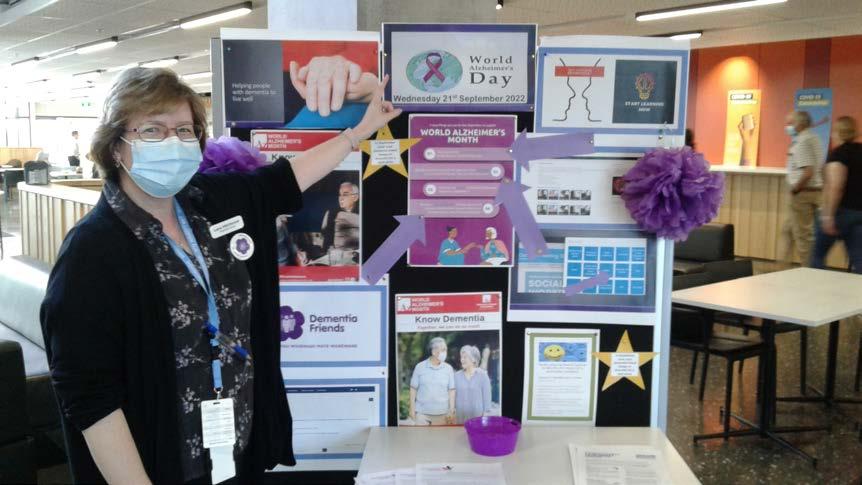
Registered Nurse Lara Hitchcock with the display at Burwood Hospital promoting dementia education and information available to staff
Registered Nurse Lara Hitchcock organised a poster display in the Burwood Hospital Atrium to mark World Alzheimer’s Day (September 21). After a break because of COVID-19, Lara announced that the next ‘See Me, Not Just My Dementia’ study day for Burwood Staff will be held on 3 November. Lara says the aim is to help those who work with people who have a diagnosis of dementia. “The course helps them to understand that the person in front of them is unwell and, very often, in a vastly different space from when they are living well with their dementia.”
Free “Dementia STARs” resources launched September also saw the launch of the New Zealand Dementia Foundation’s new set of educational resources called Dementia STARs, with Waitaha Canterbury staff having starring roles. This resource includes a set of eight educational videos narrated by Psychiatry of Old Age Academic Lead Researcher Susan Gee, and feature a gallery of other Waitaha Canterbury staff including Occupational Therapist Tracey Hawkes, Old Age Psychiatrist Matthew Croucher, Nurse Manager MacKenzie Ebbett, Speech Language Therapist Ashleigh Farr, and Registered Nurse Lara Hitchcock. Dementia STARs stands for Short Trainings in Awareness and Responsiveness. Each module introduces a person-centred approach to a key element of care when supporting people living with dementia, with an educator kit and videoed presentation. The content is pitched at a level that will be comfortable for all staff, especially kaiawhina (support-workers /care-givers), Susan says. “It’s been a huge project but it’s such a thrill to see it out in the world.”
It is free to register to access the resources at https://www.nzdementia.org/Dementia-Stars


Nurses’ Memorial Chapel receives special gift
It was a very special moment last week when Shirley Smallbone gifted Blanche Marion Huddleston's service medals to the Nurses' Memorial Chapel at Christchurch Hospital. Shirley was a relative of Blanche, who was a highly decorated nurse in WW1.
After hearing about Blanche from her mother (a cousin), Shirley set out to discover as much as she could about Blanche’s service as a member of the New Zealand Army Nursing Service (NZANS), NZEF 22/95. Blanche was born in Christchurch in 1876 and trained at Wellington Hospital as her family had moved to the North Island, qualifying in 1905. In August 1914, she left Wellington at three days’ notice to sail to Samoa on the Atua and commenced her service there.
Blanche went on to serve at hospitals in England and France for the next four years. Blanche had a humble and compassionate nature, Shirley says.
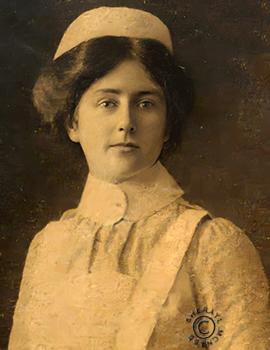
Blanche Huddleston
In a letter Blanche wrote to inform a family of the death of one of her patients while she was at Codford Hospital in England, she wrote: “He was such a nice patient and went so peacefully. We had every hope at first of his recovery and were so sorry to lose him. I always think that one cannot do enough for our brave soldier boys – they give up everything for their country – I am ever so sorry to be the bearer of such bad news.”
In France, Blanche served at several Casualty Clearing Stations on the Somme. Situated near the front line, they dealt with the wounded as quickly as possible before sending them on to base hospitals. Enemy planes came over on bombing raids every clear night. The sisters would sit on stools in their dugouts wearing a tin helmet with flasks of hot tea and sandwiches and watch the enemy fly over. In 1918, Blanche was one of the first three, out of only six, NZANS nurses to spend three months being trained by the American forces as an anaesthetist. This was hugely significant as even to this day, nurses are generally not trained as anaesthetists, only doctors are. Blanche served as an anaesthetist at the Casualty Clearing Station in Pas de Calais, France, and was awarded the Medaille de la Reine Elisabeth from the King of Belgium. Returning home to New Zealand, Blanche continued her nursing career at Wellington Hospital but never practiced anaesthetics again. Blanche died at Rannerdale Annexe for Returned Servicewomen in Christchurch and is buried at Ruru Cemetery in the Returned Services section.
Along with her three war service medals and the Medaille de la Reine Elisabeth, Blanche received the Royal Red Cross from King George V, which was later upgraded to Royal Red Cross Medal First Class for distinguished services in connection with military hospitals in France and Flanders. Getting Blanche’s medals to the Christchurch Hospital Nurses’ Memorial Chapel also has a story of its own.
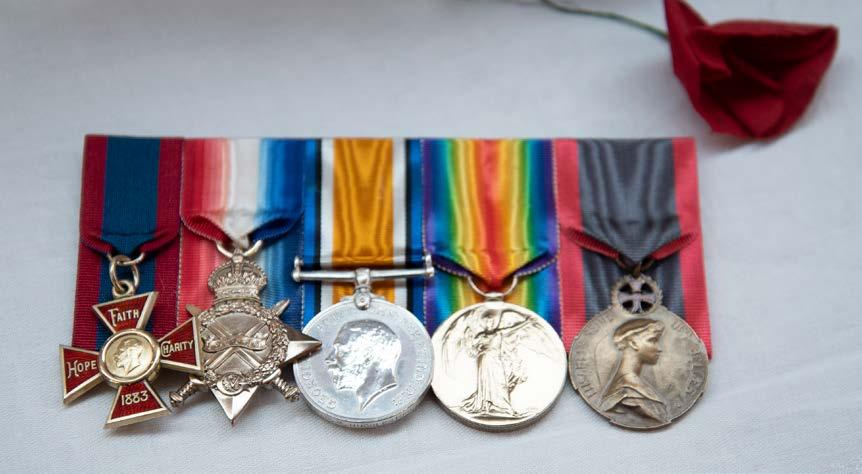
Blanche’s medals
Several years ago, Shirley discovered that a late sister of Blanche had requested Blanche’s medals to be hung in the chapel at Wellington Hospital. Sadly that chapel is no longer, so after three months of searching, the medals were found wrapped in newspaper in a drawer, with others not claimed. “I didn’t want the medals to be left in a cabinet and forgotten about. I wanted them to come to the Nurses’ Memorial Chapel at Christchurch Hospital, however, as with so many heritage buildings in Christchurch, the 2011 earthquakes caused significant damage to the chapel and it was unclear if this was going to be possible,” Shirley says. So after holding on to the medals all this time, it was an exciting and emotional moment when Shirley officially presented Blanche’s medals to President of the Friends of the Nurses’ Memorial Chapel Pip Mason. “I feel she (Blanche) has come home and is with her sisters, in the true sense of the word. I’m so happy she’s here.”
If this story of Blanche’s courage and dedication hasn’t already given you goosebumps, on the morning of Shirley arriving to the chapel, Convenor of the Museum Subgroup of the Nurses’ Memorial Chapel records Nanette Ainge says that as she was putting out a book of military records, and placed the book down and started to open it, it fell to a page with a photo of Blanche and her nursing unit in Wisques, France in 1918. This section of the book talked of Blanche’s unwavering bravery and ability to remain unnerved. In it Blanche wrote: “I am glad I am not nervous and hope I never shall be. It must be difficult to keep one’s self in hand as well as the patients.” Following the presentation of the medals, Shirley generously shared stories about what she knew of Blanche and her character – that in the face of tragedy and sadness, Blanche remained patriotic and high-spirited. “Blanche would always be on the lookout for other New Zealand nurses during her travels and would hang so far out the train window to wave and call out to her sisters that someone would have to grab onto her feet and hang onto her to stop her falling out.” The presentation of the medals fittingly coincided with Women’s Suffrage Day, providing the opportunity to reflect on the impact incredible women such as Blanche have had on shaping our history. Friends of the Nurses’ Memorial Chapel plan to pay further homage to Blanche’s service next year on International Nurses Day (12 May 2023). More about Blanche’s life is documented in a book written by R.E. Rawstron in 2005 called ‘A Unique Nursing Group. New Zealand Army Nurses Anaesthetists of WW1.’

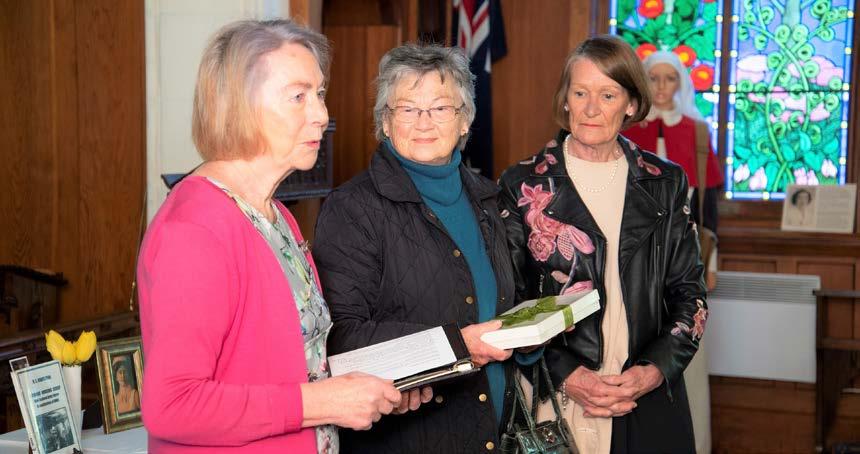
From left, Convenor of the Museum Subgroup of the Nurses’ Memorial Chapel Records Nanette Ainge, Shirley Smallbone and President of the Friends of the Nurses’ Memorial Chapel Pip Mason
From left, Shirley Smallbone and Convenor of the Museum Subgroup of the Nurses’ Memorial Chapel Records Nanette Ainge
